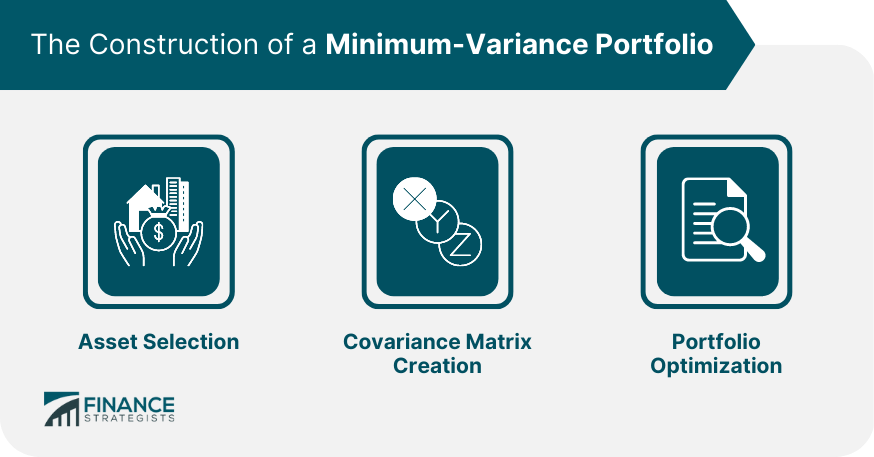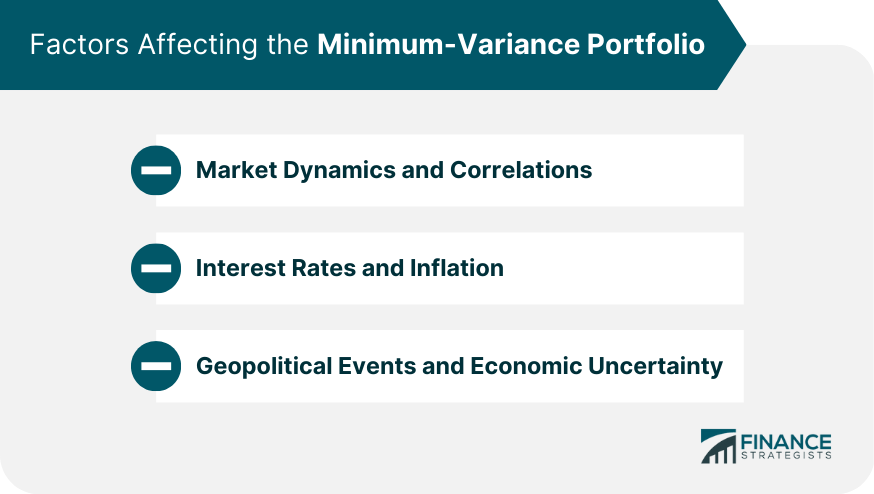A minimum-variance portfolio is an investment strategy aimed at constructing a diversified portfolio of assets to minimize overall portfolio risk and volatility. This approach seeks to achieve the lowest possible level of risk for a given set of assets by optimizing asset allocation based on historical return correlations and volatility. The primary objective of a minimum-variance portfolio is to reduce the overall risk of the investment portfolio. The benefits of this approach include potentially lower portfolio volatility, improved risk-adjusted returns, and increased resilience during periods of market turbulence. However, the minimum-variance approach may also have certain drawbacks, such as the potential for lower long-term returns compared to riskier strategies, reliance on historical data and correlations, and the need for periodic rebalancing and monitoring. Modern Portfolio Theory (MPT), developed by Harry Markowitz in the 1950s, emphasizes the importance of diversification in managing investment risk. By combining assets with low correlations, investors can reduce the overall risk of their portfolio without sacrificing expected returns. The efficient frontier is a concept in MPT that represents the set of optimal portfolios that offer the highest expected return for a given level of risk. The minimum-variance portfolio is located at the leftmost point on the efficient frontier, representing the portfolio with the lowest possible risk. The Capital Market Line (CML) is a line that connects the risk-free rate (such as a Treasury bill) to the market portfolio on the efficient frontier. The CML represents the portfolios with the highest Sharpe ratio, a measure of risk-adjusted returns. A minimum-variance portfolio will typically lie below the CML, indicating that it may provide lower risk-adjusted returns compared to other optimal portfolios. The first step in constructing a minimum-variance portfolio is to select a group of assets with low or negative return correlations. This may include a mix of stocks, bonds, commodities, and other investment vehicles from various sectors, industries, and geographical regions. Next, a covariance matrix is created to measure the degree to which the returns of the selected assets move together. The standard deviation of each asset's returns is also calculated to measure its individual risk. Mean-variance optimization is a mathematical technique that involves solving a quadratic programming problem to find the optimal asset allocation that minimizes the portfolio's variance, subject to certain constraints such as target return or asset weight limits. The risk-parity approach aims to equalize the contribution of each asset to the overall portfolio risk. This can be achieved by allocating more capital to assets with lower risk and less capital to assets with higher risk. Equal weighting involves allocating an equal percentage of the portfolio to each asset, regardless of their individual risk characteristics. While this approach may not result in the lowest possible portfolio risk, it can still provide some level of diversification benefits. Minimum-variance portfolios typically exhibit lower risk than traditional market-weighted portfolios. This can lead to higher risk-adjusted returns, as measured by metrics such as the Sharpe ratio or the Sortino ratio. While minimum-variance portfolios may provide lower absolute returns than more aggressive strategies, they often outperform traditional portfolios and benchmarks during market turbulence or heightened volatility periods. This can make them an attractive option for risk-averse investors or those seeking to protect their portfolios from downside risks. The performance of minimum-variance portfolios may vary depending on market conditions. In stable or bullish markets, they may underperform more aggressive strategies due to their focus on risk reduction. However, during market stress or heightened volatility periods, minimum-variance portfolios may outperform as investors seek safer investments. Minimum-variance portfolios can particularly appeal to risk-averse investors who prioritize capital preservation and stable returns over aggressive growth. By minimizing portfolio risk, these investors may be able to achieve more consistent returns and reduce the likelihood of significant losses. For individuals approaching retirement or seeking income-generating investments, minimum-variance portfolios can provide a more stable source of returns while minimizing the risk of capital erosion. This can be especially important as investors transition from wealth accumulation to wealth preservation and income generation. Investors looking to manage market volatility and reduce the impact of market fluctuations on their portfolios may also find minimum-variance portfolios to be a suitable investment strategy. By focusing on reducing risk, these portfolios can help provide a smoother investment experience during periods of market turbulence. Market dynamics and changing correlations between asset returns can affect a minimum-variance portfolio's optimal allocation and risk characteristics. Investors should regularly review and update their portfolio to ensure it continues providing the desired risk reduction benefits. Changes in interest rates and inflation can also impact the performance of a minimum-variance portfolio, as they may alter the risk-return characteristics of various asset classes. Investors should monitor changes in economic conditions and adjust their portfolios accordingly. Geopolitical events and periods of economic uncertainty can lead to increased market volatility and shifts in asset correlations. Investors should remain vigilant and be prepared to adjust their minimum-variance portfolios in response to these changing conditions. Regular rebalancing and monitoring are essential for maintaining the desired risk characteristics of a minimum-variance portfolio. Investors should periodically review their portfolio's performance, asset allocation, and risk profile to ensure that it continues to meet their investment objectives. Investors may choose to combine active and passive strategies within their minimum-variance portfolio to balance the benefits of active management, such as security selection and tactical asset allocation, with the lower costs and potential tax efficiency of passive investing. Derivatives, such as options and futures, can be used to manage risk within a minimum-variance portfolio. For example, investors can use put options to protect against downside risk or employ futures contracts to hedge against interest rate or currency risks. Minimum-variance portfolios play a crucial role in risk management by helping investors construct diversified portfolios that minimize overall risk while providing potentially attractive risk-adjusted returns. This approach can be especially beneficial during periods of market volatility or for risk-averse investors seeking capital preservation and consistent returns. Ultimately, the suitability of a minimum-variance portfolio depends on an investor's individual risk tolerance, investment objectives, and time horizon. By carefully considering these factors and implementing a well-constructed minimum-variance portfolio, investors can achieve greater diversification and risk management in their investment portfolios.What Is a Minimum-Variance Portfolio?
Modern Portfolio Theory and Minimum-Variance Portfolio
The Role of Diversification
The Efficient Frontier
The Capital Market Line
The Construction of a Minimum-Variance Portfolio
Asset Selection
Covariance Matrix Creation
Portfolio Optimization
Mean-Variance Optimization
Risk-Parity Approach
Equal Weighting

Performance of Minimum-Variance Portfolios
Risk-Adjusted Returns
Comparison to Traditional Portfolios and Benchmarks
Market Conditions Impacting Performance
Applications of Minimum-Variance Portfolios
Risk-Averse Investors
Retirement and Income-Oriented Portfolios
Market Volatility Management
Factors Affecting the Minimum-Variance Portfolio
Market Dynamics and Correlations
Interest Rates and Inflation
Geopolitical Events and Economic Uncertainty

Minimum-Variance Portfolio Management Strategies
Rebalancing and Monitoring
Incorporating Active and Passive Strategies
Use of Derivatives for Risk Management
Conclusion
Minimum-Variance Portfolio FAQs
A Minimum-Variance Portfolio is a portfolio with the lowest possible risk level, given the specific set of assets and their correlation with each other.
A Minimum-Variance Portfolio is constructed by calculating the covariance matrix of the assets, then using an optimization algorithm to find the portfolio weights that minimize the variance of the portfolio.
Investing in a Minimum-Variance Portfolio aims to minimize the portfolio's risk while still achieving a reasonable level of return. This is particularly useful for risk-averse investors who are willing to sacrifice potential returns for lower risk.
A Minimum-Variance Portfolio differs from other types of portfolios, such as Maximum Sharpe Ratio Portfolio or Maximum Return Portfolio, in that it prioritizes risk reduction over potential returns.
One of the main drawbacks of investing in a Minimum-Variance Portfolio is that it may underperform other portfolios during market upswings. Additionally, the portfolio may not necessarily be diversified, which could lead to concentration risk if a few assets in the portfolio are negatively impacted.
True Tamplin is a published author, public speaker, CEO of UpDigital, and founder of Finance Strategists.
True is a Certified Educator in Personal Finance (CEPF®), author of The Handy Financial Ratios Guide, a member of the Society for Advancing Business Editing and Writing, contributes to his financial education site, Finance Strategists, and has spoken to various financial communities such as the CFA Institute, as well as university students like his Alma mater, Biola University, where he received a bachelor of science in business and data analytics.
To learn more about True, visit his personal website or view his author profiles on Amazon, Nasdaq and Forbes.











